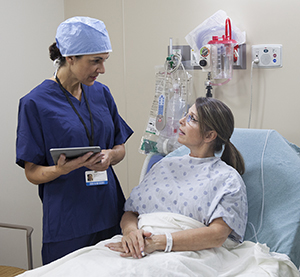Jaw (Orthognathic) Surgery: Your Surgical Experience
Jaw (Orthognathic) Surgery: Your Surgical Experience

The day of surgery
When you arrive at the hospital, you’ll change into a hospital gown. Staff will then prepare you for surgery.
An IV (intravenous) line will be started to provide you with fluids and medicines.
You’ll meet with an anesthesiologist or nurse anesthetist. This is to discuss the medicine (general anesthesia) that will be used to keep you asleep and free of pain during surgery.
Once you’re under anesthesia, the surgery will take place.
To help stabilize the bite, a plastic splint may be placed between the chewing surfaces of your teeth. In some cases, elastic bands or wires are attached to braces to hold the jaws firmly shut. In other cases, looser elastic bands called “guiding elastics” are used. Sometimes, no wires or bands are needed.
Right after surgery
After surgery you’ll awake in a recovery room.
Your IV will remain in place.
You’ll most likely have a device to give you oxygen.
Ice packs will be applied to your face to control swelling.
Your face will most likely be numb, but you’ll be given medicine if you feel any pain.
Nurses will keep watch over you to make sure you’re recovering well from anesthesia.
You’ll then be taken to a regular hospital room.
Recovering in the hospital
You’ll be urged to get up and walk as soon as possible after surgery. This helps you recover from anesthesia. It also helps prevent complications.
Sometime late in the day, you’ll likely be started on liquids.
Using facial muscles helps reduce swelling, so try to talk if you can.
It’s common to have some nausea the first day. Vomiting when you can’t open your jaws can be scary, but don’t panic. Since you fasted before surgery and you’re now taking only liquids, the vomit will be liquid. Just lean over and spit it out. If you have any concerns about how nausea may affect you, talk to your surgeon ahead of time.
Going home
You will most likely stay in the hospital overnight, or for up to 2 days. You can go home when you’re up and around, you have no signs of complications, and your nausea is under control.
Before you leave you’ll be told how to reduce pain, swelling, and nausea at home.
You’ll also be given prescriptions for medicines to help control these problems.
Risks and complications
Risks and possible complications of surgery include:
Short-term (temporary) pain and swelling
Bleeding
Numbness (in most cases temporary)
Infection
Loss of teeth or bone
Relapse (bones move back toward original positions)
Risks of anesthesia
Updated:
December 17, 2017
Sources:
Khechoyan, D. Orthognathic Surgery: General Considerations. Seminars in Plastic Surgery. 2013, iss. 27, ed. 3, pp. 133-136., Plastic Surgery: Indications and Practice. Guyuron, B. 2009, ed. 1, p. 581.
Reviewed By:
Finke, Amy, RN, BSN,Image reviewed by StayWell art team.,Kapner, Michael, DDS